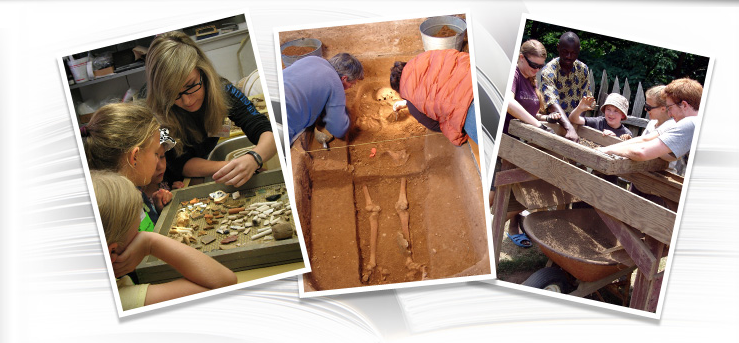2013 Week 9
This will be a short report as the week was shortened by a number of factors. At the beginning of the week, field school went on its annual trip to Virginia and visited both Williamsburg and Jamestown. In Williamsburg, we took a tour of their archaeology lab and visited the Market Square site. After the official activities, the students were given time to wander around the historic area. The next day was spent at Jamestown. We first went to Historic Jamestown, saw the current excavations, toured the lab facility and the museum. That afternoon, we were welcomed at Jamestown Settlement where we toured the museum and saw the outside exhibits. These events were important so that the students could see how archaeology is done by other institutions and how history and archaeology are interpreted to the public. To all the professionals and volunteers who made our trip so interesting we extend our heartfelt thanks.
Returning to the site on Thursday, we began to prepare for Tidewater Archaeology Days. As part of our public presentation, we wanted to get the circular feature to a point where it would be recognizable by our visitors.
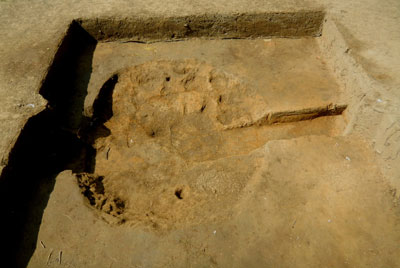
Overall picture of progress on the barrel well.
The feature was still being cleaned when the photo was taken but it shows the circular area in the center surrounded by the hard packed clay. As the feature extends further to the left, and is deeper in that area, it is likely that the water that caused the walls to erode came from that direction. Within the dark center area, there are patches of lighter clay soil. These are part of the surrounding clay fill that fell into this area while it was still open. We have removed several of these in cleaning the feature and they are thin slices of light clay lying on dark silt.
Tidewater Archaeology Days were held on Friday and Saturday.
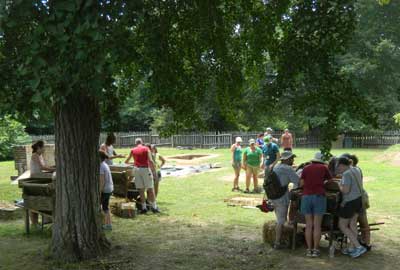
Visitors screening on Tidewater Archaeology Days.
We had a good crowd and the weather was absolutely perfect. Spent the days excavating units either to find fences or to fill in holes in our sample distribution. Attendees were able to find quite a large number of artifacts and the students got to interact with a diverse group of people. They realized just how much they have learned over the past nine weeks.
One of the interesting things found this weekend was a bottle base with a prominent pontil scar.
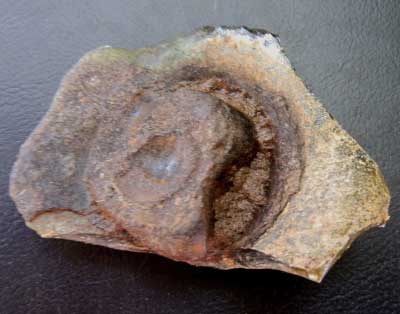
Glass bottle base with prominent pontil scar.
In the 17th century, each bottle was hand made by a glass blower. He would get some glass on the end of a hollow rod called a blow pipe and blow through the pipe to form the bottle. To finish the bottle, he attached a solid rod, called a pontil, to the base and then broke the top off the blowpipe. With the pontil attached, the bottle top could be reheated and molded. The photo shows the lump of glass left on the bottle base after the pontil was removed.
Not surprisingly, visitors to Tidewater Archaeology found a lot of ceramics.

Two pieces of highly decorated Rhenish blue and gray stoneware
This photo shows two pieces of Rhenish blue and gray stoneware. Over the past few weeks, I have shown a number of pieces of this ceramic because of the beauty of the colors. The piece on the left is the most magnificent sherd of this type of ceramic I have ever seen. Both of the pieces are highly decorated. When archaeologists think of Rhenish stoneware, we often view it as utilitarian vessels used for transporting wine. Examples like those illustrated here, remind us that some of these vessels were every bit as elegant as the elaborate table glass found on the site. These vessels would have been at home on any gentleman’s table in the 17th century.
The final artifact illustrated this week is a piece of lead printing type, showing a side view and the letter portrayed.
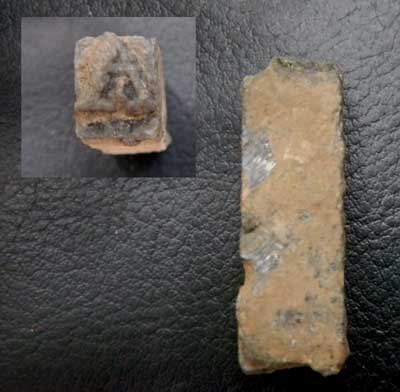
Piece of lead printing type with a capital A.
This is a very rare type of artifact and caused quite a stir when it was found. William Nuthead, who came to Maryland in 1684, was the earliest printer working south of New England. His story is an important one for the museum and we have a reconstructed press which is similar to what he used. The question on everyone’s mind this weekend was how this artifact ended up on the site. There is no evidence that Nuthead’s press was ever set up at the Calvert House. As I told many of the visitors, a full day of printing on that type of press could raise a powerful thirst in the printer. The Calvert House was the closest and biggest Ordinary or tavern nearby. It may be that William Nuthead, with some pieces of type in his pockets, came over at the end of day.
Next week will be the last of field school and we have much to be done.


